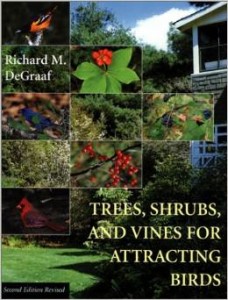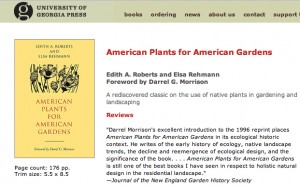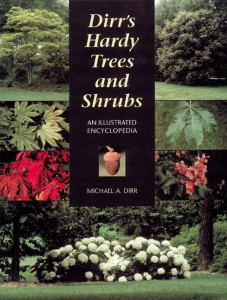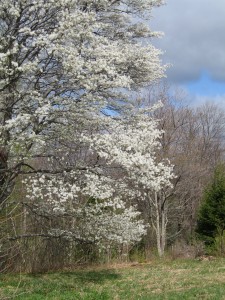Two Books and a Seminar: Musings on the State of the Landscape Profession
March 28, 2015 by admin
Filed under Book Reviews, In the News
Every now and then it’s good to stop and reflect on why and how you do what you do, and recently I had a couple of opportunities to examine the current state of my own motivation and thoughts on a few aspects of landscape design.
First, I had the honor of being the subject of a small business profile in Turf Design Build magazine. Answering the questions they asked proved to be an interesting exercise.
The audience for Turf Design Build is a professional one, so they asked me about business challenges as a member of the green industry as well as long-term goals, sources of inspiration, how and why certain landscapes give me special enjoyment, and more. I took the chance to share a few ideas that have occupied me in recent years, including the ecological impact of gardening and the importance of context for landscaping choices. I hope you’ll take a moment to follow the link and read it.
They also asked me to identify favorite landscape design books. There are many I could have named, but I wanted especially to mention ones I felt were truly educational with a long shelf life as reference books. First, the works of Richard DeGraaf, a Massachusetts-based wildlife biologist (and not just because his publisher is my own publisher, the University Press of New England). His Trees, Shrubs & Vines for Attracting Birds is a beautiful book just chock full of practical information for gardeners who are trying to build more bird-friendly habitats. I also encourage gardeners to read his books on wildlife since plant life and wildlife are so intimately connected.
The second recommendation was what I called “an obscure little book” called American Plants for American Gardens. Written in the 1920s for an audience in the Hudson Valley of New York (but inexplicably reprinted in 1996 by the University of Georgia Press, to which I am very grateful), it was one of the first gardening books (perhaps the first?) to take an ecological approach. It was quite remarkable for its time, and in many ways decades ahead of its time. It’s still available for purchase, and those of you who would like to examine it before buying may be able to get it from a local library. (I can see online that a handful of copies are available through the Connecticut interlibrary loan system.)
Given the fact that I don’t think a lot of people are aware of this little gem, imagine my surprise when, a few weeks ago, I attended a seminar led by Larry Weaner of Larry Weaner Landscape Associates and in the course of his presentation he mentioned and recommended…American Plants for American Gardens!
Weaner’s name has come to be associated with meadows, but that’s much too narrow a slot to put him in. His work attempts to reconcile the needs and desires of people with the needs and floral/faunal “trajectory” (as he would say) of the land they live on. I have been moving in the same direction for many years myself, and it was an education to see examples of projects in which he’s tried to implement practical landscape designs based on ideas that resonate with my own. I strongly encourage every gardener in the Northeast to hear Larry speak if the opportunity arises, and go with an open mind about what the goal of a landscape should be.
I expressed similar sentiments (or attempted to, at least) in my answers to the questions Turf Design Build asked me, although in a much shorter format. I’m so pleased and encouraged to find that ecology as a vital aspect of landscape design finally seems to be gaining traction both in the mind of the gardening public and on the drawing tables of the landscape profession. I hope this trend continues to gain momentum, and if it’s new to you, that you’ll explore and find value in it as you make your own landscaping choices.
Listen to GardenLine Radio Nov. 8!
November 5, 2014 by admin
Filed under In the News, Shade Gardening

I’ll be a guest of GardenLine radio host C.L. Fornari (shown here) this Saturday, Nov. 8, 8:00-10:00 am. Please call in with your questions!
I’m excited to be doing my first-ever radio interview this coming Saturday, November 8! I’ll be a guest of long-time radio host C.L. Fornari, whose show GardenLine airs on WXTK 95.1 FM out of Cape Cod on Saturdays from 8:00 am to 10:00 a.m. in the Eastern time zone.
Not in WXTK’s broadcast area? You can hear it live-streamed at the WXTK website. From the home page, click on “Listen Live” in the upper right-hand corner (and be sure to turn your sound up!).
This is a live, call-in show, so if you have any gardening questions for me (or C.L.), dial (888) 998-5951 or (508) 775-9985 on Saturday morning and talk to us. We’ll be following your lead, and this would be a great opportunity to get more information about any topic in The Shady Lady’s Guide to Northeast Shade Gardening that you wish I’d covered in more detail!
In addition, I’m hoping we’ll get to a few things that have been on my mind lately, such as this thought that I shared with C.L. a few weeks ago:
“I have found that over time my entire thought process about gardening has shifted dramatically. I rarely think of plants in terms of “like” or “dislike,” for instance; instead, I think about what the plant is capable of doing. Basically, I focus on a plant’s strengths rather than my subjective reaction to it. I see gardening largely as a problem-solving exercise.”
So, whether you’re trying to solve a gardening problem or want to share one of your own solutions, please join us! I’m looking forward to talking with you then.
Real Dirt Redux/More on Picking Plants
June 15, 2014 by admin
Filed under Garden Design, In the News
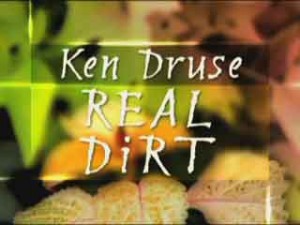 So, when I’m not gardening, I can often be found writing about gardening or talking about gardening. Apparently unaware of just how much I can talk about gardening, “gardening superstar” Ken Druse foolishly invited me to chat with him on his podcast and public radio program Real Dirt. But it’s actually my second time as his guest, which means he had no excuse!
So, when I’m not gardening, I can often be found writing about gardening or talking about gardening. Apparently unaware of just how much I can talk about gardening, “gardening superstar” Ken Druse foolishly invited me to chat with him on his podcast and public radio program Real Dirt. But it’s actually my second time as his guest, which means he had no excuse!
To hear our latest conversation at Ken’s website, click here; for the older podcast, click here and scroll down until you come to the May 7, 2010 episode.
In the new segment, we commiserate a bit about Ken’s frustration with garden media outlets (we will not name names) that are sometimes guilty of talking about plants as if they were furniture. Ken says that equating gardening with decorating the outdoors will just get you into trouble, and I agree. We also talk about favorite shade plants and how gardeners can make better choices by learning to value traits like resistance to disease and deer browsing more highly, instead of focusing solely on flowers. This is basically a matter of separating your wants from your needs with respect to garden plants, and training yourself to give adequate weight to the latter.
I’d been wanting to write a blog post on this subject, anyway, because of a recent experience that I thought illustrated the point pretty well. Not long ago, I had occasion to offer advice to someone seeking a replacement for an ash tree that had met its demise. She specified some challenging conditions the tree would have to tolerate, including clay soil that can get very dry in July and August; a hardiness zone (5B); a desired height at maturity (minimum 30 feet), and if possible, ornamental flowers and/or fruit. If it had ornamental flowers, she wanted it not to conflict with specimens of Rhododendron catawbiense (a late spring bloomer) planted nearby. She also wanted it to be fast growing yet not weak, which in my opinion was the most problematic of her requests because as a general rule those two traits are mutually exclusive (i.e., fast growing usually implies weak-wooded and short-lived), although some trees are worse than others in that regard.
So, given all these needs and wants, what would you do to find a suitable tree if you didn’t have a panel of experts to ask? The approach I recommended reminded me of the old adage about the difference between giving a hungry man a fish and teaching a hungry man how to fish (presumably after giving him a fish anyway so he was no longer hungry, but I digress…).
Rather than give her a list of suggestions, I told her how I would go about generating a viable list. (In my analogy, this would be teaching her how to fish.) First, I referred her to an excellent woody plant book (Dirr’s Hardy Trees and Shrubs by Michael A. Dirr) that I knew to contain lots of lists of trees by characteristic, including height, tolerance of heat and drought, etc. By cross-referencing lists for the most important of the traits she needed, she could come up with a short list, and then whittle it down further by considering lower priority traits.
By starting off with just height, tolerance of dry soil, and cold hardiness, she would have come up with a list of about a dozen trees. About half of those could then have been eliminated on the basis of their weak wood, tendency to become “weed trees,” or other undesirable characteristics. Candidates that remained included our native thornless honey locust (Gleditsia triacanthos var. inermis) and Indian bean tree (Catalpa speciosa or C. bignoniodes), as well as non-native European hornbeam (Carpinus betulus) and hedge maple (Acer campestre).
At that point, she would have had to do some additional research to settle on the one that was best for her. It would also have been advisable to research specific superior cultivars. As a last step, I’d call my local cooperative extension office or agricultural experiment station to discuss my final round draft picks, as well as to make sure none of my choices were on my state’s list of banned or invasive plants. (Click here to visit a website with links to invasive plant information by state.)
Interestingly, one tree that my approach didn’t generate (because it wasn’t on the height list in Dirr’s book that I would have expected) would also have been an excellent choice, in my opinion: tree-form shadblow (Amelanchier arborea or perhaps A. x grandiflora). I gushed about this beauty in my post Alight with White: Native Flowering Trees to Brighten Spring Days. While shadblow is usually thought of as wanting to grow at the woodland edge, I know from observation that wild, native shadblow in my area naturally grow in very punishing conditions on hot, dry, south-facing slopes. Whether nursery stock available at retail could be expected to perform like that is one of the things I’d discuss with the woody plant experts at cooperative extension. But regardless, it’s got a lot going for it: a moderate growth rate (resulting in a reasonably long age and reasonably strong wood), a very attractive form, subtly striated bark, delicate flowers that appear far earlier than those of Rhododendron catawbiense and would not cause a conflict, small fruits that birds eat and hence don’t cause a big mess, good fall color, and much more.
But even without that tree on the list, the process would have generated some good choices and functioned like a signpost pointing the gardener in the right direction. It would have formed the basis for a useful conversation with cooperative extension. Finally, it could have helped circumvent a problem gardeners don’t always anticipate: with some regularity, the woody plant you go to the nursery intending to buy isn’t available, or perhaps you just can’t find a good specimen. You want to have a second choice, and even a third, just in case your first choice can’t be found with ease. I am fond of saying that gardeners should almost always go to nurseries knowing in advance what they want to buy. This process helps you get to a place of confidence about your prospective garden addition, and also helps keep you from getting derailed if your number one choice doesn’t work out.
So, what I just described is basically the problem-solving process I go through every time I’m called on to choose plants. It can be applied to perennials with just a few modifications, taking into account that failure is much more likely with perennials than with woody plants, in part because perennials are much more prone to animal browsing. It really just boils down to recognizing that what you need is just as important as what you want, and trying to strike a satisfactory balance. If you try this method, let me know how it works for you!
Celebrating Small Flowers
February 6, 2011 by admin
Filed under In the News, Plant Rant
This post marks the first time my blog also appears in the Christian Science Monitor online. Their Diggin’ It feature is a great place to read the thoughts and opinions of garden bloggers from around the country, and I hope to contribute on a regular basis.
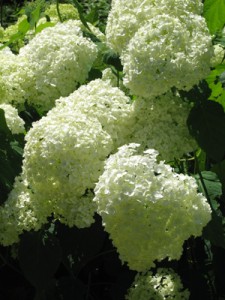
Hydrangea 'Annabelle' is a bit too, well, buxom
For as long as people have been growing plants for beauty instead of utility, plant breeders have had an obsession with developing ever bigger flowers. Within reason, that’s understandable. Sometimes, there’s no harm in having a little more of something you like (I’m thinking blueberry pie). But there comes a point with any good thing at which more is just too much.
Today, nurseries are full of plants with flowers so enormous and weighty they literally can’t hold themselves up. I mean, if Hydrangea arborescens ‘Annabelle’ were a person, she’d be a candidate for breast reduction surgery on grounds of medical necessity.
Plant breeders aren’t the only ones to blame, of course. Someone had to buy all those oversized horticultural wonders. I’m not pointing fingers, but you know who you are. (And I admit that I’m one of them, although I’m recovering.)
Well, I’m here today to celebrate the (sometime) superiority of small flowers.
Consider the peony. Nearly every Paeonia lactiflora (the common herbaceous peony—the plant most people think of when you say “peony”) you can find at a retail nursery will have gigantic bombe-type flowers. They’re upwards of six inches across and fully double with hundreds of petals. When open, they weigh so much that their stalks will bend or break, leaving the flowers in the dust, as a result of a decent rain or a good gust of wind. In other words, all it takes is some normal weather to cause them to collapse.
Peony hoops really aren’t much help. They just cause the stalks to bend and break above the level of the hoop, as opposed to lower down. Staking methods that attempt to solve this problem, such as a circle of chicken wire, are (in my opinion) ugly and time-consuming. I’m looking more for “attractive and easy” gardening methods, or better yet, “do nothing at all” methods.
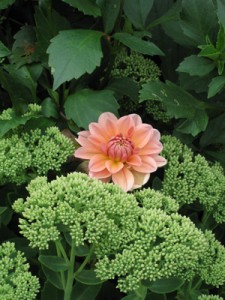
My "Goldilocks" dahlia—just the right size
I just don’t understand why people put themselves through this when, by growing single peonies, they could avoid the problem altogether. Take a look at these beautiful single peonies from Hidden Springs Flower Farm. At most, these plants need a single hoop encircling the whole clump just to hold them upright in case of some really severe weather.
Dahlias are pretty much the same story. Certain dark forces in the world of horticulture would have you believe that so-called “dinner plate” dahlias are the most desirable and obviously worth their premium price. You’ll never catch me buying them, though. My favorite dahlia is this unidentified orange one pictured at left that a client in my garden design business shared with me many years ago. Its flowers are about three inches across and perfect for flower arrangements because they’re in scale with black-eyed Susans and other perennials that flower in mid to late summer when the dahlia does. I see similar ones in catalogs all the time…usually at a cheaper price than their overgrown relatives. Yes, the plant as a whole requires a great big tomato cage, but the individual stems are perfectly capable of holding up the flowers without additional support.
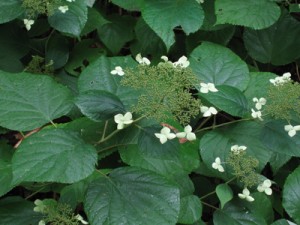
Hydrangea arborescens ssp. radiata holds up its head in all kinds of weather
I mentioned Hydrangea arborescens ‘Annabelle’ already. I still grow her, but she is a handful. I’d much prefer a cultivar with flowers about half the size, but wishing doesn’t make it so. (I’m not the only one. Read blogger Tim Wood’s extensive ramblings about hydrangeas here.) One alternative is to grow the species or its subspecies, H. a. ssp. radiata, both of which produce lacecap floral displays instead of foot-wide snowballs. (There are many other lacecap types, but they won’t bloom reliably in Zones 5 and colder.) These choices won’t fall to pieces after a summer downpour.
My message here is that bigger is not necessarily better. Supersize flowers can come with supersize maintenance requirements. That doesn’t make them bad…just more work. As the old saying goes, “the bigger they are, the harder they fall,” and that’s enough of a reason for me to celebrate small flowers.
My Podcast Debut
May 11, 2010 by admin
Filed under In the News
The other day, I reached one of those milestone moments: my first time participating in a podcast. I was honored to chat with garden guru Ken Druse for his online program Real Dirt. If you haven’t listened to Real Dirt before, you’ll want to check it out. Ken talks with people from all corners of the horticulture world and touches on all manner of subjects interesting to gardeners.
My talk with Ken is the second half of the May 7, 2010 show. We discuss cottage gardening, personalizing outdoor spaces and the payoff gardeners get from improving their soil. Scroll down and you’ll find lots of other fascinating people, plants and garden projects Ken has brought to his audience. He and I would both appreciate it if you’d please visit, listen and comment.



